According to the general division, the Internet of Things is divided into three parts: the sensing layer, the network layer and the application layer. The sensing layer, as the data source of the network layer transmission and the data foundation of the application layer calculation, plays a vital role. The important components that make up the sensing layer are a variety of sensors.
Sensors can be divided into different categories according to different divisions. For example, according to the measured non-electrical physical quantity division, it can be divided into a pressure sensor and a temperature sensor.

According to the working mode when converting non-electrical physical quantities into electrical physical quantities, it can be divided into energy conversion type (no additional energy access when working) and energy control type (additional energy access when working). In addition, it can be divided into ceramic sensors and integrated sensors according to the manufacturing process.

Distance sensor: The distance sensor can be divided into optical and ultrasonic according to the pulse signal emitted during ranging. The principle of the two is similar, by sending a pulse signal to the measured object, receiving the reflection, and then calculating the distance of the measured object according to the time difference, the angle difference and the pulse speed.
Light sensor: The working principle of the light sensor is to use the photoelectric effect to convert the intensity of ambient light into a power signal through a photosensitive material. Depending on the photosensitive material of different materials, the light sensor will have various divisions and sensitivities.
Temperature sensor: The temperature sensor can be roughly divided into two types, contact type and non-contact type. The former is to let the temperature sensor directly contact with the object to be measured to sense the temperature change of the measured object through the temperature sensitive element, and the latter is The temperature sensor is kept at a certain distance from the object to be tested, and the intensity of the infrared rays emitted from the object to be tested is detected, thereby calculating the temperature.
Smoke sensor: According to the detection principle, the smoke sensor is commonly used in both chemical detection and optical detection. Once smoke enters the sensor, it affects the normal movement of positive and negative ions, causing corresponding changes in voltage and current. The calculation can determine the strength of smoke.
Commonly used heart rate sensors: The principle of sensitivity to blood changes using infrared light of a specific wavelength. Due to the periodic beating of the heart, the blood in the blood vessel is regularly changed in flow velocity and volume, and the current number of heartbeats is calculated through signal noise reduction and amplification processing.
Angular Velocity Sensor: An angular velocity sensor, sometimes called a gyroscope, is based on the principle of conservation of angular momentum. A general angular velocity sensor consists of a rotor that is located at the axis and rotatable. The direction of motion and relative position of the object are reflected by the rotation of the rotor and the change in angular momentum.
The most common angular velocity sensor use scene is a mobile phone. For example, the famous mobile game such as Need for Speed is mainly an interactive mode that generates the left and right swing of the car through the action of the angular velocity sensor. In addition to mobile phones, angular velocity sensors are currently widely used in navigation and positioning and AR/VR.